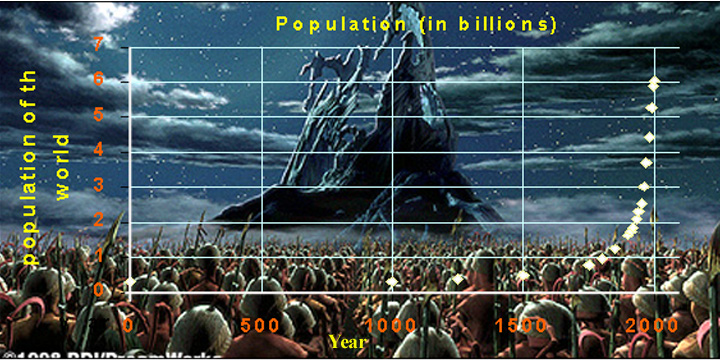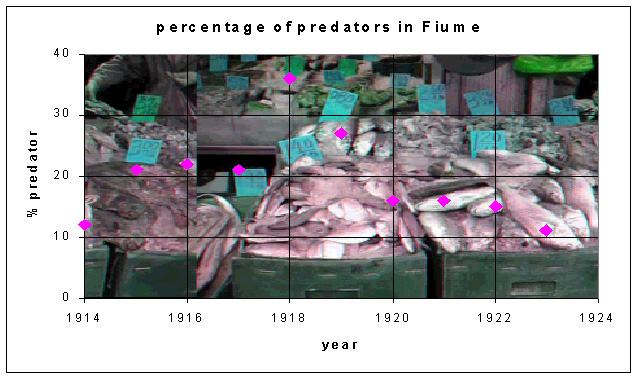Predator-Prey Modeling
Introduction
-
Professor Short introduced Epidemic Models
-
Mathematical models showed that a disease like malaria could be extinguished
without destroying all mosquitoes
-
Ecological significance is that below a critical number populations can
go extinct
-
We examine the population dynamics of a simple predator-prey system
Ecology of Predator-Prey System

this image kindly provided by Tom
and Pat Leeson, who retain the copyright
-
Hudson Bay company kept careful records of all furs from the early 1800s
into the 1900s
-
Assume that furs are representative of the populations in the wild because
of the trapping intensity and trapping techniques
-
Records of furs showed distinctive oscillations with a period of about
12 years for lynx and hares
-
Lynx primarily eat snowshoe hares, which makes this a rare two species
(simplified) interaction - (Mathematical models have a hard time understanding
multiple species interactions)
-
Ecologists have predicted that in a simple predator-prey system that a
rise in prey population is followed (with a lag) by a rise in the predator
population - when the predator population is sufficiently high, then the
prey population begins dropping - thus, oscillations occur
-
Can a mathematical model predict this?
-
What causes cycles to slow or speed up? What affects the amplitude of the
oscillation or do you expect to see the oscillations damp to a stable equilibrium?
-
The models tend to ignore factors like climate and other complicating factors
- how significant are these?
Basic Population Model
-
Single species growth model with population Pn
and growth function g(Pn)
is given by
Pn+1
=
Pn +
g(Pn).
-
Malthusian Growth model satisfies
Pn+1
=
Pn +
kPn = (1 +
k)Pn.
-
This equation is easily solved (recall compound interest problems)
Pn
= (1 +
k)Pn-1 = (1 +
k)(1 +
k)Pn-2
= (1 +
k)2Pn-2
Pn
= (1 +
k)nP0
-
This gives exponential growth. Until recently and with a few exceptions
like the plague years, human growth has been very consistently Malthusian.
-
When the growth function g(Pn)
is more complicated, then other mathematical techniques are needed. We
will use computer simulations.
Predator-Prey Model (Lotka-Volterra)
-
Define the hare population by Hn
and the lynx population by Ln
-
Assume the primary growth of the hare population is Malthusian, a1Hn,
(in the absence of lynx) and that the lynx population, -b1Ln,
(in the absence of hares) is negative Malthusian
-
Assume that the primary loss of hares is due to predation (contact) with
lynx, -a2HnLn,
and that the growth of the lynx population is from energy derived from
eating hares, b2HnLn
-
The Lotka-Volterra model is given by
Hn+1
=
Hn +
a1Hn -
a2HnLn
Ln+1
=
Ln -
b1Ln +
b2HnLn
Simulation of the Model
-
Excel worksheet to be developed!
Model of Fishing
-
Following World War I, Volterra examined the fishing data for Italy and
discovered that the percent of sharks and skates in the fishing catch rose
during the years of the war
Percentages of
predators in the Fiume fish catch
| 1914 |
1915 |
1916 |
1917 |
1918 |
1919 |
1920 |
1921 |
1922 |
1923 |
| 12 |
21 |
22 |
21 |
36 |
27 |
16 |
16 |
15 |
11 |
 |
-
These data don't show oscillations, but there is clearly a rise and fall
of the percent of sharks and skates in the fish catch due to effects of
the war. What caused this?
-
Volterra used the predator-prey model to show why this effect could be
predicted
-
Let Fn be the food fish
population and Sn be the
shark and skate population. To the Lotka-Volterra model, we add the effects
of human fishing (using nets, -a3Fn
and - b3Sn ),
then the mathematical model becomes
Fn+1
=
Fn +
a1Fn -
a2FnSn
-
a3Fn
Sn+1
=
Sn -
b1Sn +
b2FnSn
-
b3Sn
Equilibria
-
An equilibrium for a population is when the population stays the same for
all time or for each value of n. For
the previous model, we have
Fn+1
=
Fn
= Fe and Sn+1
=
Sn
= Se
-
It can be shown (mathematically) that the average population about a cycle
of the Lotka-Volterra model is its equilibrium value. Thus, if the fishing
populations are cycling less than annually, the annual catch should reflect
the equilibrium population
-
Substitute the equilibrium information into the equations above
Fe
=
Fe +
a1Fe -
a2FeSe
-
a3Fe
Se
=
Se -
b1Se +
b2FeSe
-
b3Se
-
Apply some algebra. The first two terms of each equation cancel, then factor
Fe
from
the first equation and Se
from
the second equation. The result is
Fe (a1
-
a2Se -
a3) = 0
Se(-b1
+
b2Fe
- b3) = 0
-
The product of two factors being zero means one of the factors is zero.
From the first equation
Fe =
0 or a1 -
a2Se
-
a3 = 0
Se =
0 or -b1 +
b2Fe
-
b3 = 0
-
Simultaneously, solving the two equations, we have the two equilibria,
either
Fe =
0 and Se
=
0
or
Fe =
(b1 +
b3)/b2 and
Se
=
(a1 -
a3)/a2
Relating Equilibria to Fishing Data
-
With NO fishing, the nonzero equilibrium
is
Fe =
b1/b2and
Se=
a1/a2
-
With fishing, the nonzero equilibrium is
Fe =
(b1 +
b3)/b2 and
Se
=
(a1 -
a3)/a2
-
Notice that as the level of fishing increases (a3
and b3 increasing), the
equilibrium value for the food fish increases, while the equilibrium for
the sharks and skates decreases. During World War I, the fishing fleets
would be less likely to go out. Thus, the level of fishing decreases, which
aids the equilibrium for the sharks and skates as reflected in the data!
Similar Application for the Agricultural Industry

-
Consider an agricultural situation, such as scale insects and lady bugs,
and the application of pesticides.
-
Without pesticides, the insects form a classical predator-prey situation
as modeled above.
-
The application of pesticides is like the situation above with the fishing
industry netting fish. The pesticide generally kills both the prey insect
(which is usually the agricultural pest) and the predator species.
-
Our analysis above shows that the prey species in the long run benefits
from this type of application. Thus, the agricultural pest actually does
better after application of pesticides (after a recovery time). This process
causes even larger amplitude oscillations, so nastier outbreaks.
-
Conclusion: The farmers and public lose
from pesticides, while the chemistry industry benefits!






